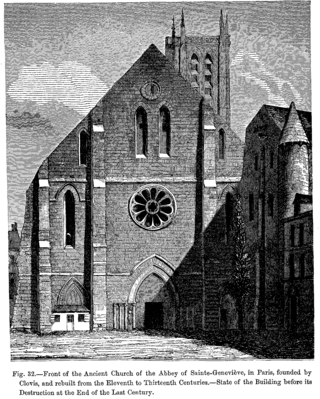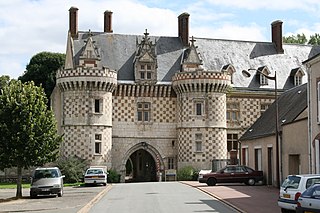
The Tironensian Order or the Order of Tiron was a medieval monastic order named after the location of the mother abbey in the woods of Thiron-Gardais in Perche, some 35 miles west of Chartres in France). They were popularly called "Grey Monks" because of their grey robes, which their spiritual cousins, the monks of Savigny, also wore.

Dammarie-lès-Lys is a commune in the south-eastern suburbs of Paris, France. It is located in the Seine-et-Marne department in the Île-de-France region 43.3 km (26.9 mi) from the center of Paris.

The Abbey of Saint-Victor, Marseille is a former abbey that was founded during the late Roman period in Marseille in the south of France, named after the local soldier saint and martyr, Victor of Marseilles.

The Archdiocese of Sens and Auxerre is a Latin archdiocese of the Catholic Church in France. The archdiocese comprises the department of Yonne, which is in the region of Burgundy. Traditionally established in sub-apostolic times, the diocese as metropolis of Quarta Lugdunensis subsequently achieved metropolitical status. For a time, the archbishop of Sens held the title "primate of the Gauls and Germania". Until 1622, the metropolitan archdiocese numbered seven suffragan (subordinate) dioceses: the dioceses of Chartres, Auxerre, Meaux, Paris, Orléans, Nevers and Troyes, which inspired the acronym CAMPONT. The Diocese of Bethléem at Clamecy was also dependent on the metropolitan see of Sens. On December 8, 2002, as part of a general reorganization of the dioceses of France undertaken, at least in part, to respond to demographic changes, the Archdiocese of Sens-Auxerre ceased to have metropolitan rank and became a suffragan of the Archdiocese of Dijon, which became the centre of a new ecclesiastical province for the Burgundy administrative region.
Faremoutiers Abbey was an important Merovingian Benedictine nunnery in the present Seine-et-Marne department of France. It formed an important link between the Merovingian Frankish Empire and the southern Anglo-Saxon kingdoms of Kent and East Anglia.

Fontaine-le-Port is a commune in the Seine-et-Marne department in the Île-de-France region in north-central France.

Vaux-de-Cernay Abbey is a former Cistercian monastery in northern France (Île-de-France), situated in Cernay-la-Ville, in the Diocese of Versailles, Yvelines. The abbey was abandoned during the French Revolution and fell into partial ruin. Most of the buildings, except for the church, were restored in the late 19th century by Charlotte de Rothschild, and the property is now a hotel.

The Abbey of Saint Genevieve was a monastery in Paris. Reportedly built by Clovis, King of the Franks in 502, it became a centre of religious scholarship in the Middle Ages. It was suppressed at the time of the French Revolution.

Preuilly Abbey was a Cistercian monastery in Égligny in the Seine-et-Marne department, France. It was located about 21 kilometres south-west of Provins and 15 kilometres east of Montereau-Fault-Yonne.

Bonneval Abbey, also known as St. Florentinus' Abbey, is a former Benedictine monastery in Bonneval, Eure-et-Loir, in France.

The Abbey of Saint-Pierre-le-Vif was a Benedictine monastery just outside the walls of Sens, France, in the Archdiocese of Sens.

The Abbey of Saint-Seine is a former Benedictine monastery located in Saint-Seine-l'Abbaye, Côte-d'Or, Burgundy, France. During the Middle Ages it was a wealthy and powerful institution. It was suppressed at the French Revolution.
Abbecourt Abbey is a former Premonstratensian monastery in Orgeval, Yvelines, France.

Joyenval Abbey was a Premonstratensian monastery located in the Forêt de Marly, in the present commune of Chambourcy, Yvelines, France.

Fontenelles Abbey or Les Fontenelles Abbey was an Augustinian monastery in the former commune of Saint-André-d'Ornay, in the Vendée, France.

Fontainejean Abbey, otherwise Fontaine-Jean Abbey, was a Cistercian monastery in the commune of Saint-Maurice-sur-Aveyron in the Gâtinais in the département of Loiret, France.

Les Écharlis Abbey is a former Cistercian monastery in Villefranche, Yonne, France. It was founded in the 12th century by a secular priest with two companions who wanted to live a monastic life. Soon afterward, the monastery joined the Cistercian order as a dependency of Fontenay Abbey.

Beaugerais Abbey is a former Cistercian abbey, located in what is now the commune of Loché-sur-Indrois, in the Indre-et-Loire département of France.















